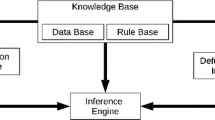Abstract
Context adaptation (CA) based on evolutionary algorithms is certainly a promising approach to the development of fuzzy rule-based systems (FRBSs). In CA, a context-free model is instantiated to a context-adapted FRBS so as to increase accuracy. A typical requirement in CA is that the context-adapted system maintains the same interpretability as the context-free model, a challenging constraint given that accuracy and interpretability are often conflicting objectives. Furthermore, interpretability is difficult to quantify because of its very nature of being a qualitative concept. In this paper, we first introduce a novel index based on fuzzy ordering relations in order to provide a measure of interpretability. Then, we use the proposed index and the mean square error as goals of a multi-objective evolutionary algorithm aimed at generating a set of Pareto-optimum context-adapted Mamdani-type FRBSs with different trade-offs between accuracy and interpretability. CA is obtained through the use of specifically designed operators that adjust the universe of the input and output variables, and modify the core, the support and the shape of fuzzy sets characterizing the partitions of these universes. Finally, we show results obtained by using our approach on synthetic and real data sets.









Similar content being viewed by others

References
Bastian A (1994) How to handle the flexibility of linguistic variables with applications. Int J Uncert Fuzziness Knowl Based Syst 2(4):463–484
Botta A, Lazzerini B, Marcelloni F (2006a) Context adaptation of Mamdani fuzzy systems through new operators tuned by a genetic algorithm. In: Proceedings of 2006 IEEE international conference on fuzzy systems. Vancouver, BC, pp 1641–1648
Botta A, Lazzerini B, Marcelloni F (2006b) New operators for context adaptation of Mamdani fuzzy systems. In: Ruan D, D’hondt P, Fantoni PF, Cock MD, Nachtegael M, Kerre EE (eds) Applied artificial intelligence. World Scientific, Singapore, pp 35–42
Casillas J, Cordón O, Herrera F, Magdalena L (eds) (2003) Interpretability issues in fuzzy modeling, vol 128. Springer, Heidelberg
Cococcioni M, Ducange P, Lazzerini B, Marcelloni F (2007) A Pareto-based multi-objective evolutionary approach to the identification of Mamdani fuzzy systems. Soft Comput 11(11):1013–1031
Cordón O, Herrera F, Magdalena L, Villar P (2001) A genetic learning process for the scaling factors, granularity and contexts of the fuzzy rule-based system data base. Inform Sci 136(1–4):85–107
Cordón O, Gomide F, Herrera F, Hoffmann F, Magdalena L (2004) Ten years of genetic fuzzy systems: current framework and new trends. Fuzzy Sets Syst 141:5–31
Cross VV, Sudkamp TA (2002) Similarity and compatibility in fuzzy set theory. Springer, Heidelberg
Deb K, Agrawal S, Pratap A, Meyarivan T (2002) A fast and elitist multiobjective genetic algorithm: NSGA-II. IEEE Trans Evol Comput 6(2):182–197
Gonzalez J, Rojas I, Pomares H, Herrera LJ, Guillen A, Palomares JM, Rojas F (2007) Improving the accuracy while preserving the interpretability of fuzzy function approximators by means of multi-objective evolutionary algorithms. Int J Approx Reason 44(1):32–44
Gudwin R, Gomide F, Pedrycz W (1998) Context adaptation in fuzzy processing and genetic algorithms. Int J Intell Syst 13(10–11):929–948
Gudwin RR, Gomide FAC (1994) Context adaptation in fuzzy processing. In: Proceedings of Brazil–Japan joint symposium on fuzzy systems, Campinas, Brazil
Ishibuchi H, Nojima Y (2007) Analysis of interpretability-accuracy tradeoff of fuzzy systems by multiobjective fuzzy genetics-based machine learning. Int J Approx Reason 44(1):4–31
Ishibuchi H, Murata T, Turksen IB (1995) Selecting linguistic classification rules by two-objective genetic algorithms. In: Proceedings of IEEE international conference on systems, man and cybernetics, vol 2. Vancouver, BC, pp 1410–1415
Jimenez F, Gomez-Skarmeta AF, Roubos H, Babuska R (2001) Accurate, transparent, and compact fuzzy models for function approximation and dynamic modeling through multi-objective evolutionary optimization. In: Proceedings of 1st international conference on evolutionary multi-criterion optimization, Zurich, Switzerland, vol 2, pp 653–667
Johnson RW (2004) New car and truck data. http://www.amstat.org/publications/jse
Klawonn F (2006) Reducing the number of parameters of a fuzzy system using scaling functions. Soft Comput 10(9):749–756
Magdalena L (1997) Adapting the gain of an FLC with genetic algorithms. Int J Approx Reason 17(4):327–349
Magdalena L (2002) On the role of context in hierarchical fuzzy controllers. Int J Intell Syst 17(5):471–493
Mamdani E, Assilian S (1975) An experiment in linguistic synthesis with a fuzzy logic controller. Int J Man Machine Stud 7(1):1–13
Michalewicz Z (1999) Genetic algorithms + data structures = evolution programs. Springer, Heidelberg
de Oliveira JV (1999) Semantic constraints for membership function optimization. IEEE Trans Syst Man Cybern Part A 29(1):128–138
Pedrycz W, Gudwin RR, Gomide FAC (1997) Nonlinear context adaptation in the calibration of fuzzy sets. Fuzzy Sets Syst 88(1):91–97
Wang H, Kwong S, Jin Y, Wei W, Man KF (2005) Multi-objective hierarchical genetic algorithm for interpretable fuzzy rule-based knowledge extraction. Fuzzy Sets Syst 149(1):149–186
Wang X, Kerre EE (2001) Reasonable properties for the ordering of fuzzy quantities. Fuzzy Sets Syst 118(3):375–405
Yuan Y (1991) Criteria for evaluating fuzzy ranking methods. Fuzzy Sets Syst 43(2):139–157
Author information
Authors and Affiliations
Corresponding author
Rights and permissions
About this article
Cite this article
Botta, A., Lazzerini, B., Marcelloni, F. et al. Context adaptation of fuzzy systems through a multi-objective evolutionary approach based on a novel interpretability index. Soft Comput 13, 437–449 (2009). https://doi.org/10.1007/s00500-008-0360-6
Published:
Issue Date:
DOI: https://doi.org/10.1007/s00500-008-0360-6



